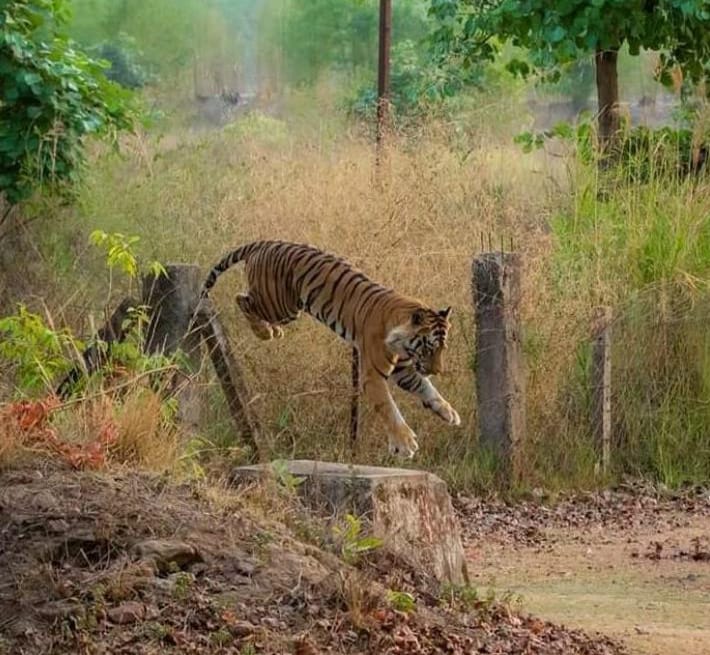
Meera Bhardwaj:
A male tiger was captured on Sunday in the combing operations at Bandipur Tiger Reserve, Karnataka. It is reported that this male tiger is responsible for the repeated attacks on people and livestock in Saraguru taluk, Mysuru district. It is reported that the tiger was captured at 2 am on 9.11.2025.
However, it is yet to be confirmed whether it is the “right tiger” that had attacked people. Forest, Ecology & Environment Minister Eshwar Khandre has instructed the Karnataka Forest Department to conduct DNA tests to confirm that it is the same tiger that was responsible for the three deaths in this region.
Further, Eshwar Khandre in a press statement has said, “I have instructed the higher authorities to check both the post-mortem report of the deceased three persons and the DNA of this tiger and to confirm whether the captured tiger is the one that had caused the loss of precious lives around Hediyala, Moleyur and Nugu.”

RISING HUMAN-WILDLIFE CONFLICT
In the wake of rising tiger attacks on human and livestock on the forest fringes of Bandipur and Nagarhole, the safaris at both Bandipur and Nagarhole tiger reserves have been suspended and the forest staff of the safaris have been deployed for the tiger capture operation.
Not only forest officers of various circles of Bandipur and Nagarhole, but also officers and staff of other circles also participated in the tiger capture operation.
This captured male tiger is reportedly about 12-13 years old and its teeth are weak. Therefore, this tiger, which was unable to hunt herbivores in the forest, may have entered the neighbouring villages and attacked people and livestock.
COMBING OPERATIONS
In view of the spate of three human deaths and one person sustaining injuries in the last one month, combing operations had been launched in Bandipur Tiger Reserve by the Karnataka Forest Department.
With suspension of safaris at Nagarhole & Bandipur and also trekking in the conflict areas, all staff and vehicles usually used for safaris were redirected to help in the operations to capture the tiger responsible for the attacks.

FOUR TIGER ATTACK INCIDENTS
- On October 16, Madegowda sustained eye injuries at Badagalapura village, Nugu Range. This happened during a tiger rescue operation when a 400-strong-crowd interfered in the operations and turned into a tragedy. The injured person had pelted stones on the tigress and three cubs.
- On October 27, 54-year-old Rajasekar was killed in Bennegere village, close to Mulluru, Saragur taluk when a tiger attacked him while collecting firewood. This village is on the edge of Nugu Range of Bandipur TR.
- On October 31, farmer Doddaningaiah was killed in Koodagi village, Saragur taluk. This area is close to Kurnigala, Bandipur-Nagarhole tiger reserves.
- On November 7th, 35-year-old Chowdaiah Naik was killed in Hale Heggodilu village, Saragur taluk. This village is on the border of Moleyur range of Bandipur TR.

EARLIER OPERATIONS IN OCTOBER
After the spate of incidents in Bandipur, capture operations were taken up in this region. On October 28, a mother tigress was captured in Hediyala sub-division, Bandipur TR.
Concerned Forest officials said this mother tigress was identified following all NTCA protocols and was held responsible for the Badagalapura attack incident. The two cubs of this tigress are missing while the remaining third cub was rescued by the forest department.

IDENTIFYING THE RIGHT TIGER VERY IMPORTANT
It is not easy to identify a tiger or tigress which has been involved in an attack incident as the forest officials have to follow a rigorous protocol and standard operating procedures given by the National Tiger Conservation Authority (NTCA).
Only after identifying the right tiger that is suspected to be responsible for killing of a human, capture operations have to be launched. The protocol for identification includes:
- DNA Analysis,
- Pug Mark &
- Stripe Pattern.

NOW HOW TO IDENTIFY?
The significance of DNA, pug mark, and stripe pattern analysis in identifying the right tiger involved in conflict situations lies in their unique and complementary abilities to accurately identify individual tigers and thereby, enable effective conflict management, say WILDLIFE FORENSIC EXPERTS from different tiger range states of India.
DNA ANALYSIS
DNA analysis from trace samples such as saliva, hair, or scat left at livestock/human kill sites is highly significant in tiger conflict identification because it enables precise identification of not just the species but the individual tiger involved.
Modern genetic tools using single nucleotide polymorphisms (SNPs) achieve over 95% success in identifying individual tigers with high confidence. This method reduces mis-identification risks and helps select the right tiger for conflict resolution, minimizing unnecessary removal of non-conflicting tigers and thereby, preventing further conflict escalation or ecological imbalance.

PUG MARK ANALYSIS
Pug mark analysis involves examining the footprints left by tigers. Though it is less precise than DNA analysis, it provides immediate clues such as the animal’s sex, age, size, and health. Multiple pug marks and gait variables can be analyzed statistically to identify individual tigers with decent accuracy, especially when measured as part of a full pug mark set rather than a single print.
However, there is potential for misidentification, particularly regarding sex determination, which DNA analysis can clarify. Pug marks are valuable for quick field assessments and tracking movement patterns related to conflict.

STRIPE PATTERN ANALYSIS
Each tiger has a unique stripe pattern analogous to human fingerprints, which allows for reliable individual identification from photographs or camera trap images. Stripe patterns also reveal age, maturity, and behavioural traits relevant to conflict tendencies.
This method helps monitor tiger populations, track known conflict individuals, and understand social structures. It aids in recognizing recurring conflict-causing tigers for targeted management interventions and conservation planning.

IMPORTANCE OF THESE SCIENTIFIC METHODS
DNA analysis offers the highest accuracy for confirming the exact tiger involved in a conflict event.
Pug mark analysis provides rapid and often preliminary identification for field teams to locate and track tigers involved in conflict. Down below is an image of the pug mark of a tiger and picturized by Imran Ali Khan, Naturalist, Corbett National Park.

Stripe pattern analysis supports individual identification and monitoring over time, especially when combined with photographic evidence.
Finally, all these methods form a robust toolkit to ensure the correct tiger is identified in conflict situations, enabling precise and effective management actions while reducing impacts on non-conflict tigers and supporting broader tiger conservation goals.

AN INTEGRATED APPROACH
This integrated approach improves human-wildlife conflict management by minimizing wrongful interventions, enhancing scientific understanding of conflict patterns, and supporting evidence-based decision-making in protecting both human interests and tiger populations.
Emphasizing the need for protection to people living on the edges of protected areas of Bandipur & Nagarhole, the Forest Minister also said that the APCCF and the tiger project director have been instructed to set up camp near residential areas where tigers are known to move and conduct operations to check whether any other tigers besides the captured one, are responsible for attacking people and livestock.
